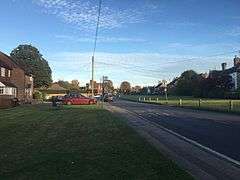Horsted Keynes
Horsted Keynes is a village and civil parish in the Mid Sussex District of West Sussex, England. The village is about 5 miles (8 km) north east of Haywards Heath, in the Weald. The civil parish is largely rural, covering 1,581 hectares (3,910 acres), and has a population of 1,586 (2011 census) (increased from 1,507 in 2001).[2] The Prime Meridian passes about 1 mile to the east of the village of Horsted Keynes.
| Horsted Keynes | |
|---|---|
 | |
 Horsted Keynes Location within West Sussex | |
| Area | 15.81 km2 (6.10 sq mi) [1] |
| Population | 1,507 [1] 2001 Census 1,586 (2011 Census)[2] |
| • Density | 95/km2 (250/sq mi) |
| OS grid reference | TQ387278 |
| • London | 32 miles (51 km) N |
| Civil parish |
|
| District |
|
| Shire county | |
| Region | |
| Country | England |
| Sovereign state | United Kingdom |
| Post town | HAYWARDS HEATH |
| Postcode district | RH17 |
| Dialling code | 01825 |
| Police | Sussex |
| Fire | West Sussex |
| Ambulance | South East Coast |
| UK Parliament | |
| Website | http://www.horstedkeynes.com/ |

Origin and history
Guillaume de Cahaignes, a French knight who participated in the Norman conquest of England, and lord of what is now Cahagnes, was given Milton in Buckinghamshire and the Sussex village of Horstede (The Place of Horses in Old English). The latter became Horstede de Cahaignes and in time Horsted Keynes. The place name is first attested in the Domesday Book of 1086. The village has been formally twinned with the Normandy village of Cahagnes since 1971. The Horsted Cahagnes Society promotes social and cultural links, and organises annual exchange visits between the two places.
On Saturday, 28 August 1624, Horsted Keynes hosted what is believed to be the earliest known organised cricket match in Sussex. Knowledge of it stems from the death thirteen days later of Jasper Vinall, on whom an inquest was held. He had suffered a head injury during the game when accidentally hit by a cricket bat.[3]
Two months before being assassinated, U.S. President John F. Kennedy slept in the parish when he stayed one Saturday night at Birch Grove, the home of the former Prime Minister, Harold Macmillan. The American Secret Service closed the village that night, siting their communication hub in the Lounge Bar of The Crown Inn.[4][5]
On 1 July 2003 a lightning bolt struck the electricity pole beside The Crown public house on the village green which has stood there for at least 300 years and probably much longer. The roof and much of the building were destroyed in one of the largest fires in the area for many years. The fire did not spread to the petrol storage tanks of the adjacent Crown Garage. In May 2007 a telephone pole was struck, removing communications from much of the village. Several homes in Lewes Road were left without a telephone service for over one month whilst permission was sought to dig on private land to relay a cable.
This part of Sussex was known for its iron industry long before the industrial revolution and the coming of the railways. Little remains of this now, except for the hammer ponds and other traces of this activity dotted around the surrounding countryside, although iron working is remembered in many local place names.
Amenities
Horsted Keynes is centred on a village green with pubs, Post Office and village store. The Post Office was to be closed down for lack of use but was bought up by a group of villagers who invested in its continued use for the community. It now serves a large rural area.
Like many other English villages Horsted Keynes is losing businesses that have been there for many years. After the closure of the main village store in 1992, and the more recent loss of the butcher, village hairdresser and photographer, the village garage closed down in June 2007. It was only 20 years ago that the village had two garages, but now it has none, leaving the nearest petrol retailer more than 6 miles (10 km) away. Planning permission was granted and the garage site has now been turned into residential accommodation.
Churches
The two principal churches are: the Anglican Parish Church dedicated to St Giles[6] and the Roman Catholic church of St Stephen which is unoccupied and controlled from the nearest town, Haywards Heath.
Railway station
The railway station, three-quarters of a mile from the village, is now owned and operated by the Bluebell Railway, which is largely run by volunteers and operates using vintage steam trains. The station originally also had a connection with Haywards Heath, between 1883 and 1963.
Notable people
- Robert Leighton (prelate) - buried here
- Harold Macmillan, former Prime Minister of the United Kingdom - buried here, alongside his wife Dorothy Macmillan.
References
- "2001 Census: West Sussex – Population by Parish" (PDF). West Sussex County Council. Archived from the original (PDF) on 8 June 2011. Retrieved 10 April 2009.
- "Civil Parish population 2011". Neighbourhood Statistics. Office for National Statistics. Retrieved 30 September 2016.
- McCann T (2004) Sussex Cricket in the Eighteenth Century, pp.xxxiii–xxxiv. Sussex Record Society.
- The lowdown on Haywards Heath | Sussex Life
- The Crown - Horsted Keynes Archived 2011-09-08 at the Wayback Machine
- Kerrigan, Michael (1998). Who Lies Where - A Guide to Famous Graves. London: Fourth Estate Limited. pp. 163. ISBN 1-85702-258-0.
External links
- HorstedKeynes.com - website for the village
- The Horsted Cahagnes Society
| Wikimedia Commons has media related to Horsted Keynes. |